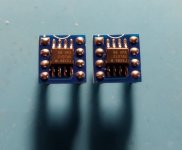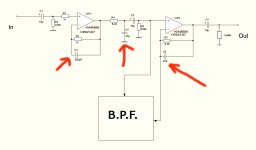So changing the LPF frequency will not affect the sound in any way?Yes possible but it will not make much difference in sonic, would take little longer to discharge.
By the way, what frequency is better to set this RC filter to? Or stick to the factory values? Any opinions?
Understood, thank you!Most modern opamps has excellent PSRR, so factory values are good enough.
Don't get confused by me calling it a low pass filter, it is, but just for the supply voltage, it's not in the signal path. Its only effect is to filter supply ripple and I agree with NanoFarad, I'm sure the engineers who designed the circuit already chose the component values the circuit requires considering the incoming ripple and the high PSRR of the opamps. I mean, if I was recapping the thing and happened to have a bunch of 100u caps in stock (which usually I do) but no 47u's, I'd use them, no harm in that, but I wouldn't expect that to make any audible difference at all.
Don't get confused by me calling it a low pass filter, it is, but just for the supply voltage, it's not in the signal path. Its only effect is to filter supply ripple and I agree with NanoFarad, I'm sure the engineers who designed the circuit already chose the component values the circuit requires considering the incoming ripple and the high PSRR of the opamps. I mean, if I was recapping the thing and happened to have a bunch of 100u caps in stock (which usually I do) but no 47u's, I'd use them, no harm in that, but I wouldn't expect that to make any audible difference at all.

Is it a TI or NS LM4562? The codes differ - TI has a 7 character code whereas NS had 8. As your code is 8 characters, I'm guessing its an LM4562 from NS.
To be honest, I didn't understand anything.Then you'll find the NS codes explained in this attached document.
Hi guys! Finally got around to changing 4559 to LM4562. Guys, the sound is just great! The resolution of the LM4562 is amazing!!! I really like it👍! No fluctuations were detected in the circuit, everything works clearly. Thank you all very much for your participation, comments and... And of course patience🙂. Good luck to everyone!
 👍
👍

 👍
👍Hi guys! After listening to 4562 for a while, I came to the conclusion that the sound with them is somehow sterile and even bright. I began to realize that it was very difficult to listen to such a sound for a long time . At first it seemed to me that this was happiness. But happiness waved its hand at me🙂. I've been listening to 2134 for a week now. It's soft, beautiful, you don't get tired of listening👍. Don't laugh too much
. At first it seemed to me that this was happiness. But happiness waved its hand at me🙂. I've been listening to 2134 for a week now. It's soft, beautiful, you don't get tired of listening👍. Don't laugh too much .
.
 . At first it seemed to me that this was happiness. But happiness waved its hand at me🙂. I've been listening to 2134 for a week now. It's soft, beautiful, you don't get tired of listening👍. Don't laugh too much
. At first it seemed to me that this was happiness. But happiness waved its hand at me🙂. I've been listening to 2134 for a week now. It's soft, beautiful, you don't get tired of listening👍. Don't laugh too much .
.Sounding a bit bright? Check the LM4562 has good decoupling, it is known to oscillate in circuits where other opamps are stable. Minimum is 100nF ceramic on each power rail to ground near the chip. The NE5532 will happily work with one ceramic between V+ and V-, the LM4562 does not in my experience... Consequence is much raised distortion and noise floors.
I have already said that there is no hesitation. Ceramics are present. Most likely, this is a feature of this chip.Check the LM4562 has good decoupling, it is known to oscillate in circuits where other opamps are stable. Minimum is 100nF ceramic on each power rail to ground near the chip.
Bit late to the party here, but low noise bipolar opamps need back-to-back diodes to protect the input transistors from reverse Vbe voltages (avalanche breakdown) during switch-on and switch-off transients - such reverse transients permanently reduce noise performance of a BJT, and the effect can be cumulative if transients happen repeatedly. Most "audio" bipolar opamps provide those protection diodes internally, especially if very low noise, or guaranteed noise performance devices.Whether the 4562 has anything like that I wouldn't like to say but I'd be 99.99% sure there is no clamping between the inputs.
Its strongly recommended to do this explicitly with power amplifier input differential pairs too.
Dear colleagues, greetings! After listening to OPA2134 for a long time, I switched to OPA2107. An amazing operational amplifier!!! I don't want to turn off the music, I like him so much! The depth and width of the stage is just a bomb! That's it, I'm finishing my experiments. All the best to everyone!
Attachments
- Home
- Source & Line
- Analog Line Level
- Replacement 4559

